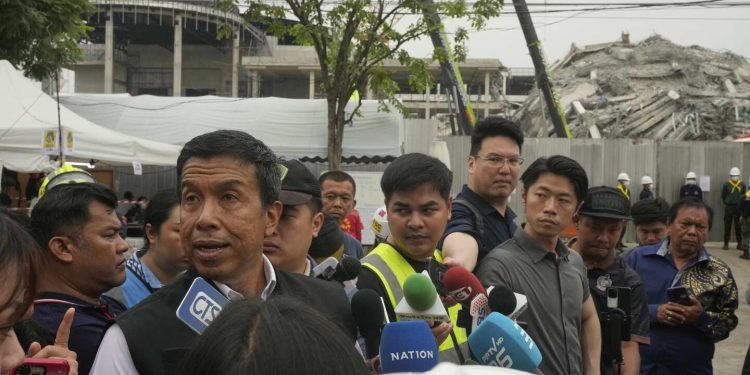Bangkok (AP) – The Thai authorities said on Monday that they were investigating the reasons why only one block of office under construction in Bangkok had collapsed for Friday trewkeake This otherwise caused limited damage in the capital.
Bangkok governor, Chadchart, Sittipunt visited the site while the heavy equipment withdrew the rubble from the 30 -storey audit building in the hope of finding the 78 disappeared.
“Even a saved life is worth every effort, so I think we have to continue, continue,” he said. But in the longer term, it is important to ensure the safety of buildings in the city, where millions of people live and work in thousands of high -rise buildings.
The earthquake of 7.7, which was centered at more than 800 miles (1,200 kilometers), killed, killed more than 1,700 The people of Myanmar and at least 18 years old in Thailand, most of them on the Bangkok construction site near the popular catuchak market.
“I think we have to find the deep cause so that at least we can learn certain lessons and improve construction regulations,” said Chadchart. “In the end, we will have results that will improve security in Bangkok.”
The actions of the real estate promoter dealing with the project, the Italian Thai development, fell 27% in the trade on Monday while questions were raised on the design of the building, the application of the construction safety codes and the Chinese entrepreneur managed by the State which builds the state audit office.
The construction company, a subsidiary of the n ° 10 engineering group of China Railway n ° 10, published last year an online video celebrating the structure of 137 meters high (approximately 450 feet), showing many images of drones and boasting of the quality of the design, construction and management of the project.
Security and quality questions
The Minister of the Interior, Anutin Charnvirakul, whose family has one of the largest construction conglomerates of Thailand, told journalists that he had ordered the implementation of an investigation committee and to bring him the results within seven days. He highlighted three possible factors behind the collapse: the designer, the inspectors or the manufacturers.
“We will certainly find the real reasons why this building collapsed, because everything is scientific,” said Anutin.
Although it is not on a geological fault, Bangkok is built on a relatively unstable alluvial soil, on the banks of the Chao Phraya river. This can amplify the movement of the soil for large buildings. The city has long sank under the weight of its skyscrapers, which led the authorities to restrict the use of groundwater to help reduce collapse.
Friday’s earthquake gave the Thai capital an unusually long and strong shock, causing pools on the cascade roof of skyscrapers, light rail trains to switch to their traces and millions of people to flee the houses and buildings. Many people waited outside hours in flamboyant heat to see if their homes and offices were safe. A replica warning Monday caused a brief panic, some people heading again in the street.
Questions on the application of safety and quality standards in Bangkok were raised earlier by the collapse of the parts of a highway under construction on the outskirts of the city who killed several construction workers. A potential concern was the quality of steel stems integrated into concrete slabs and pillars to strengthen them.
Most of the city’s other damage seemed superficial, such as fallen ceiling panels and cracked plaster and plaster, and mainly in relatively recent buildings set up by private developers.
Revised construction standards
Chadchart said that owners of buildings were to inspect their properties to determine whether cracks were old or new. Structural Thailand Engineers Association recruited volunteers to help inspections. Recently, he asked for an examination of all large -scale projects in the city.
Most Bangkok buildings were built before the government revised construction standards to require security requirements for earthquakes, said Christian Malaga-Chuquitaype, professor of civil and environmental engineering at Imperial College in London.
Many structures are built without beams using “flat slabs” and thin columns, which maximizes the open floor space and minimizes costs, he noted. The company building the state audit office boasted in its video that it used a beamless design.
“Although this conception has costs and architectural advantages, it works badly during earthquakes, often failing in a fragile and sudden (almost explosive) way,” he wrote in an analysis. “An in-depth forensic analysis is necessary, but this type of building is no longer recommended in areas subject to earthquakes.” ___
The writers of the associated press David Rising and Grant Peck contributed.


